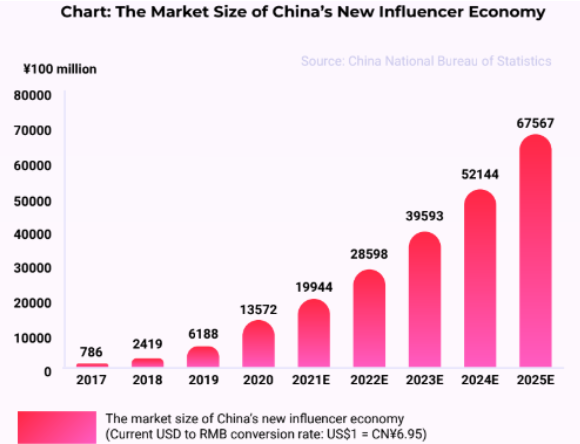In China's quickly developing digital community, InfluChina has actually emerged as a critical method for brand names seeking to develop meaningful connections with critical consumers.
Efficient brand awareness rests upon collaborations with authentic Key Viewpoint Leaders (KOLs), whose trustworthiness and credibility are deeply ingrained among their followers.
By grasping the nuances of KOL engagement and the cultural context in which they run, brands can significantly augment the success and reliability of their projects.
An advanced technique to influencer marketing in China requires the recognition of the most suitable influencer type, the production of culturally resonant material, and the cautious allotment of spending plans.
As the Chinese market continues to go through fast changes, an extensive expedition of its intricacies can unveil unique chances for development, development, and optimization.
Key Takeaways
InfluChina utilizes influencer marketing to establish connections with critical Chinese consumers, promoting trust and credibility through authentic partnerships with key viewpoint leaders (KOLs) To succeed in this market, it is important to collaborate with influencers who possess extensive understanding of regional markets and develop material that resonates with the target audience's cultural subtleties.
Selecting the proper influencer type, whether macro, mid-tier, micro, or nano, is vital to line up with particular organization objectives in China. Macro influencers provide broad reach, while mid-tier and micro influencers provide greater engagement rates and specific niche know-how. Nano influencers, though less recognized, can facilitate genuine, grassroots connections.
To establish efficient marketing techniques in China, comprehending audience demographics, interests, and choices is important. Conducting market division analysis enables targeted projects that deal with distinct customer groups. Accomplishing a beneficial return on financial investment (ROI) in InfluChina projects requires balancing budget allowance between mega and micro influencer collaborations, taking into consideration rates tiers and content production expenses.
By adopting a tactical method to influencer marketing, companies can navigate the intricacies of the Chinese market and develop meaningful connections with their target audience.
Influencer Marketing in China
In China's dynamic digital environment, influencer marketing has emerged as an important method for brand names to get in touch with the nation's sophisticated and critical consumers.
The effectiveness of this technique hinges on the authenticity of Secret Viewpoint Leaders (KOLs), who promote trust amongst their fans by promoting items that line up with their values, competence, and persona.
By teaming up with authentic KOLs, brands can browse China's intricate digital landscape, establish a robust online existence, and drive brand presence.
Effective influencer marketing projects in China need a nuanced understanding of KOL engagement, influencer credibility, and the cultural context in which they operate.
Authentic KOL partnerships can elevate brand credibility, facilitate significant connections with target audiences, and eventually drive service growth in China's competitive market.
Structure Brand Awareness Successfully
Structure reliable brand awareness in China's digitally-driven market needs a tactical mix of art and science. This involves navigating the complex social media landscape and collaborating with influencers who form customer viewpoints.
To drive brand name understanding and engagement, methods must focus on cultural subtleties, social media platform selection, and influencer collaborations.
Secret Methods for Structure Brand Name Awareness in China:
- Targeted Social Network Usage: Take advantage of popular platforms like Weibo, Douyin, and Xiaohongshu to reach diverse audiences.

- Influencer Cooperation: Partner with influencers who possess extensive understanding of regional markets and audience preferences.
- Culturally Pertinent Material Development: Develop material that resonates with Chinese customers and aligns with regional patterns.
- Continuous Tracking and Optimization: Frequently track project efficiency and change strategies to make the most of brand awareness and consumer engagement.
Types of Chinese Influencers
China's influencer landscape is defined by a varied variety of characters, each with distinct strengths and audience connections. The nation's vast influencer swimming pool can be classified into various tiers, consisting of Macro Influencers, Mid-Tier Influencers, Micro Influencers, and Nano Influencers, each serving special purposes.
Macro Influencers, boasting 100K to 500K fans, excel at brand awareness and conversion. They are ideal for business looking for to increase their presence and drive sales.
Mid-Tier Influencers, with 10K to 100K fans, offer a balance between reach and engagement, making them appropriate for services seeking to construct brand name trustworthiness and trust.
Micro Influencers, having 1K to 10K fans, concentrate on niche markets, supplying targeted influence and high engagement rates. They are perfect for companies aiming to develop a strong market existence and boost brand name loyalty.
Nano Influencers, with less than 1K fans, are extremely reliable at constructing trust and promoting individual connections with their audience. They are ideal for businesses looking for to boost their credibility and drive word-of-mouth marketing.
Reliable Key Viewpoint Leader (KOL) engagement relies on determining the best influencer type for specific service objectives. Establishing targeted influencer techniques is vital for effective market penetration in China's vibrant market.
By comprehending the roles of different influencer types, brands can tailor their techniques to make the most of trust building, brand presence, and eventually, drive organization development.
Note: The customized text provides a more extensive summary of the various kinds of influencers in China, consisting of Mid-Tier and Micro Influencers, which were missing from the original text. It likewise uses more accurate language and meanings to guarantee semantic accuracy, completeness, and consistency. Additionally, it integrates connotative, social, affective, and emotive meanings to make the text more engaging and relatable.
Developing Personalized Marketing Strategies
Establishing customized marketing strategies for the Chinese market demands an extensive understanding of the complex characteristics at play, incorporating a varied variety of influencer types and their particular strengths. Customizing methods to suit specific audience sectors is crucial for effective targeting.
Key Factors To Consider for Developing Custom-made Marketing Strategies:
- Target Market Identification: Plainly specify the preferred audience's demographics, choices, and interests to inform influencer selection and content production, ensuring positioning with the brand name's goals.
- Market Segmentation Analysis: Conduct an extensive market analysis to figure out the most efficient platforms and influencer types for the target market, thinking about aspects such as age, area, and interests.
- Influencer Alignment and Partnerships: Select influencers whose values, proficiency, and audience engagement line up with the brand's goals, messaging, and target audience, promoting genuine and impactful cooperations.
- Culturally Pertinent Material Creation: Develop material that resonates with the regional audience, taking into consideration cultural subtleties, preferences, and sensitivities, consequently improving brand credibility and audience engagement.
Navigating Influencer Project Costs
Identifying the financial expense for an efficient influencer project involves a nuanced stabilizing act, necessitating careful factor to consider of interconnected aspects, consisting of influencer prices, material production and distribution expenses, and possible return on financial investment.
In the Chinese market, influencer pricing changes significantly based on reach, engagement, and specific niche, with mega influencers commanding higher costs and micro influencers using cost-efficient alternatives due to their smaller sized, extremely engaged audiences.
To enhance influencer marketing achieve and spend maximum ROI, brand names must have a profound understanding of the Chinese influencer landscape, audience demographics, and marketing goals, carefully browsing these intricacies to guarantee tactical spending plan allotment.
Influencer project budgeting needs a tactical approach, considering the varied rates tiers of influencers, material production costs, and circulation expenses.
A comprehensive understanding of the Chinese influencer ecosystem, including influencer categorization, audience insights, and marketing goals, is important for reliable budgeting.
Brands should weigh the benefits of partnering with mega influencers versus the benefits of collaborating with micro influencers, whose smaller sized audiences frequently demonstrate higher engagement rates.
By doing so, brand names can optimize their influencer marketing ROI, foster meaningful connections with their target market, and preserve a competitive edge in the dynamic Chinese market.
Ultimately, browsing the intricacies of influencer campaign costs demands a complex method, incorporating insights from the Chinese influencer landscape, audience demographics, and marketing goals to inform strategic budgeting decisions.
Often Asked Concerns
How Does Influchina Measure the Success of Influencer Marketing Campaigns?
Influchina measures the success of influencer marketing campaigns by tracking key performance indications (KPIs) such as campaign reach, impressions, and conversions, which supply quantitative insights into project effectiveness.
Furthermore, metrics like remarks, likes, and shares provide qualitative insights into audience engagement, making it possible for brands to assess the effect of their influencer collaborations.
Can I Utilize the Very Same Influencer Marketing Technique in China as Worldwide?
Executing a consistent influencer marketing technique internationally is ineffective in China due to distinct cultural subtleties and platform choices that need tailored techniques.
Chinese customers react much better to Why not give this a try? localized material and trust Key Opinion Leaders (KOLs) who comprehend and show their values.
A one-size-fits-all method ignores these complexities, hindering brand visibility and credibility in the Chinese market.
To succeed, brand names should adapt their methods to accommodate China's unique digital landscape, highlighting cultural importance and localized messaging to promote trust and engagement with the target market.
What Is the Normal Period of an Influencer Marketing Campaign in China?
The normal period of influencer marketing projects in China differs based on project objectives, timelines, and market trends.
Brand awareness projects usually last 6-8 weeks, while conversion-driven campaigns can reach 3-6 months.
Campaigns lining up with peak seasons, such as Songs' Day or Chinese New Year, typically see adjusted periods to optimize influencer collaborations and regional market engagement.
Reliable campaign timing is essential for influencing target audiences and accomplishing desired outcomes.
How Does Influchina Ensure Brand Safety and Compliance in China?
In China's complex and dynamic influencer landscape, meticulous planning is essential for making sure brand name safety and compliance. Adherence to brand name guidelines is vital, while navigating regulatory obstacles and cultural subtleties demands specific competence.
Effective compliance methods encompass extensive vetting of influencers, strenuous content tracking, and transparent communication channels. By focusing on these crucial elements, brand names can reduce dangers, preserve a favorable reputation, and prevent serious repercussions associated with regulative non-compliance in the Chinese market.
Ultimately, a tailored approach is essential for maintaining brand integrity and making sure long-term success.
If I Do Not Have a Resident Company Entity?,### Can I Work With Chinese Influencers.
Working with Chinese influencers without a regional organization entity is feasible, however requires mindful consideration of regulatory and legal requirements to reduce possible threats. Collaborations can be developed through intermediaries or third-party companies that manage contractual and payment processes, guaranteeing compliance with Chinese laws and guidelines, including tax laws and marketing policies.
Brands need to focus on adherence to these guidelines to avoid charges and reputational damage. Using companies familiar with Chinese regulative structures can help with smoother partnerships and reduce the danger of non-compliance.
Efficient collaborations with Chinese influencers require a deep understanding of the regional market, cultural nuances, and regulatory landscape, underscoring the significance of thorough research and strategic planning.
Conclusion
Reliable influencer marketing in China requires a comprehensive strategy that incorporates extensive knowledge of the influencer community with customized methods aligned to particular service objectives. By navigating the intricacies of China's digital landscape and leveraging appropriate social media platforms, brand names can substantially enhance their visibility, trustworthiness, and trust among Chinese customers. A culturally informed, data-driven, and versatile methodology is essential for driving sales and promoting long-lasting relationships in the vibrant and rapidly developing Chinese market.
Key considerations for effective influencer marketing in China consist of:
- Developing a nuanced understanding of the Chinese influencer community, consisting of the varied series of influencer types, their audience demographics, and the social media platforms they utilize.
- Crafting customized techniques that line up with unique service goals, such as brand name awareness, product promo, or consumer engagement.
- Leveraging significant social media platforms, consisting of WeChat, Weibo, Douyin, and Xiaohongshu, to reach target market and enhance brand name messaging.
- Incorporating culturally relevant content and messaging that resonates with Chinese customers and promotes trust and reliability.
- Using information analytics and performance metrics to monitor campaign efficiency, determine locations for improvement, and optimize influencer marketing techniques.
By embracing a comprehensive, culturally informed, and data-driven approach to influencer marketing, brands can successfully navigate the complexities of the Chinese digital landscape and achieve their business objectives in this dynamic and rapidly developing market.
Selecting the proper influencer type, whether macro, mid-tier, micro, or nano, is vital to align with particular business objectives in China. Macro influencers use broad reach, while mid-tier and micro influencers offer higher engagement rates and specific niche know-how.Note: The customized text supplies a more extensive summary of the various types of influencers in China, including Mid-Tier and Micro Influencers, which were missing out on from the original text.Effective influencer marketing in China requires a detailed method that incorporates in-depth knowledge of the influencer community with customized techniques aligned to specific company goals. By browsing the complexities of China's digital landscape and leveraging appropriate social media platforms, brand names can substantially improve their presence, trustworthiness, and trust amongst Chinese customers.
 Hallie Eisenberg Then & Now!
Hallie Eisenberg Then & Now! Kelly McGillis Then & Now!
Kelly McGillis Then & Now! Ashley Johnson Then & Now!
Ashley Johnson Then & Now! Heather Locklear Then & Now!
Heather Locklear Then & Now! Justine Bateman Then & Now!
Justine Bateman Then & Now!